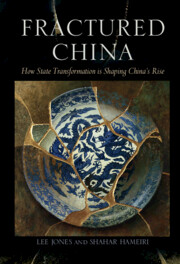Book contents
- Fractured China
- Fractured China
- Copyright page
- Dedication
- Contents
- Figures
- Maps
- Tables
- Acknowledgements
- Abbreviations
- Introduction
- 1 State Transformation and Chinese Foreign Policy
- 2 State Transformation and the South China Sea
- 3 Chinese Non-Traditional Security Governance in the Greater Mekong Subregion
- 4 China’s International Development Financing
- Conclusion
- References
- Index
1 - State Transformation and Chinese Foreign Policy
Published online by Cambridge University Press: 21 October 2021
- Fractured China
- Fractured China
- Copyright page
- Dedication
- Contents
- Figures
- Maps
- Tables
- Acknowledgements
- Abbreviations
- Introduction
- 1 State Transformation and Chinese Foreign Policy
- 2 State Transformation and the South China Sea
- 3 Chinese Non-Traditional Security Governance in the Greater Mekong Subregion
- 4 China’s International Development Financing
- Conclusion
- References
- Index
Summary
This chapter elaborates the theoretical and methodological approach used in this book. Guided by Gramscian state theory, we trace the post-1978 rise of a powerful, though divided, cadre-capitalist class, and the associated, uneven and contested fragmentation, decentralisation and internationalisation of China’s party-state. We then elaborate a theoretical model capable of explaining how policymaking and implementation work under these changed conditions: the Chinese-style regulatory state. In this model, rather than making detailed, binding decisions and strategies, top leaders try to loosely steer and coordinate a plethora of actors towards favoured ends. But other actors can influence, interpret and even ignore these policy frameworks. Chinese behaviours thus represent an ongoing struggle within the fractured party-state. Outcomes are further shaped by socio-political dynamics within the other countries in which Chinese actors operate. The chapter also explains our method and case selection, and canvasses and rejects some predictable objections to our argument: that China’s state transformation is nothing new, and that recentralisation under Xi Jinping has made the state transformation argument outdated.
Keywords
- Type
- Chapter
- Information
- Fractured ChinaHow State Transformation Is Shaping China's Rise, pp. 20 - 71Publisher: Cambridge University PressPrint publication year: 2021

